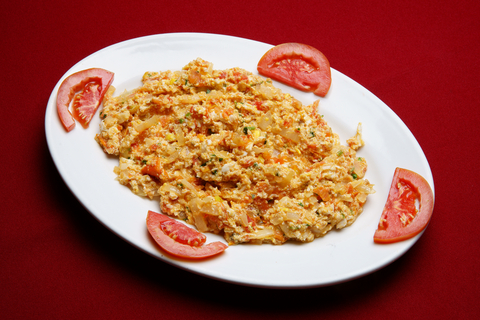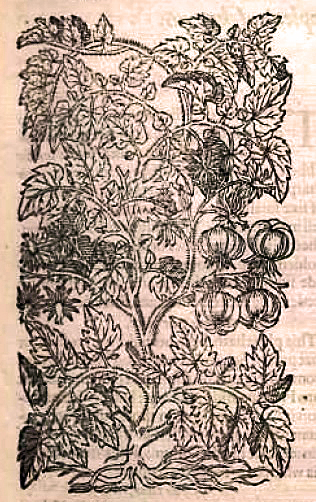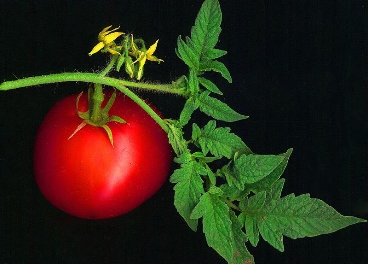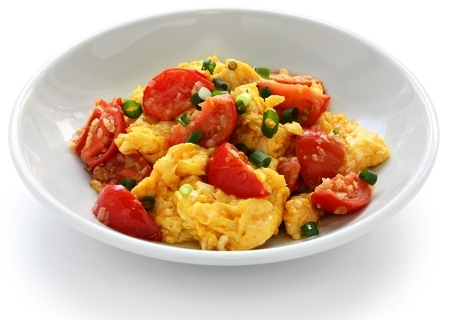Tomato Eggs is a home-cooked Chinese dish that reminds students, travelers, and those living abroad of home. Just a whiff of this cooking and folks will tell tales of sitting in or near the kitchen as a kid as a parent made this dish – and how good it tasted! it is simple, elegant, and savory, and less than 10 – 15 minutes from wok to table. Chopped green onions are almost always used. Sometimes garlic or onion is added, and often there is a blast of shaoxing, rice vinegar, or even oyster sauce to add flavor. Some recipes also add sugar to counter the acidity of the tomatoes, but the memorable taste of the dish usually just comes from the combined flavors of the fresh ingredients.
The form of the dish can be dry, like in the picture above, or is can be moist with a thin tomato sauce, or even soupy. It is often served over or with rice or fresh noodles. My travels tend to make me think that presentation varies mostly by individual preference and not by geography, because I have had both dry and wet forms in a number of different places.
I’ve enjoyed this dish all over China, from Beijing and Xian to places much further west and south. Although the Chinese regard this as a quintessential Chinese dish, my favorite thing about tomato eggs (蕃茄炒蛋/西红柿炒蛋) is that it is probably Arab in origin.
The Arab dish that Tomato Eggs most resembles is Shakshuka. This dish is eaten all over the Saudi Peninsula, North Africa, and the Levant. Turkey even has its own version called Menemen. Although the form varies a great deal, from the dry, Saudi version pictured here, to poached eggs over a spiced tomato sauce as in Egypt and Israel, to a complex ragout of vegetables (with lots of tomatoes) and sometimes bits of meat or sausage bound together by eggs. It is almost always served with pita bread or naan. Onions are almost always used and sometimes garlic is as well. Spicing can be just salt and pepper with a little bit of chopped parsley or cilantro as in Oman to a dish flavored with cumin, or dishes with oregano and other herbs. Chili peppers or ground chilies are often added, but I have never had a Shakshuka that I could call hot. These days, cheese is sometimes added, but that is a modern addition and not found in traditional recipes for the dish in any of the cultures that now enjoy it.

A comparison of the Saudi and Chinese recipes show that the recipes are nearly identical, although the Chinese use a two-step cooking process:
The main reasons why this is probably another west-to-east spread of a recipe is the commonality and variations of the dish in the Muslim Mediterranean, Suez and Persian Gulf, and the unusual nature of the dish in China’s litany of egg recipes. Another reason why it is likely a dish with an “Arab” origin is that Muslim people took to the tomato very early on in its introduction in the Old World. While the Europeans were generally skittish about eating this member of the nightshade family, and raised them as curiosities or ornamental garden plants, the Muslims dove right in and cultivated them as food early on in their arrival in the Eastern Hemisphere. The Spanish were the only Europeans who generally took to eating the tomato in the 16th Century. This is probably because they saw them being cultivated and eaten in the New World and knew that they were not harmful.

The Spanish were said to particularly enjoy them with cooked with oil, salt, and pepper as a sort of stew, and also to make a sauce out of them with vinegar added to the ingredients above and to use that sauce on their meats (Gerarde, History of Plants, 1597). Gerarde also notes that tomatoes or “Love Apples” grow well in warm climates like Spain and Italy. Of interest, perhaps, is that Gerarde describes both red and yellow tomatoes.
Although there is mention that the Italians also ate tomatoes in 17th Century botanicals, this is repetition of incorrect information. The original citation says that the Italians ate, “Eggplants”. This, even in historical documents became misreported as, “tomatoes”, and the error continues to proliferate today.
Evidence for the early Arab love of eating tomatoes can be found in John Parkinson’s 1629 Earthly Paradise, in which he reports that tomato plants grow well in hot climates like those in, “Barbary and Ethiopia”. Parkinson’s 1640 Theatrum Botanicum expands this range of growth in the Old World to, “easterly countries such as Egypt, Syria and Arabia.” His 1629 work notes that tomatoes are much eaten in the hot countries where they grow well.
Lancelot Addison’s 1671 work, An Account of West Barbary, notes that tomatoes are eaten raw with oil along with other, “salads.” In 1710, Dr. William Salmon’s Herbal notes that the Spanish ate tomatoes boiled in vinegar with pepper and salt, and served up with oil and lemon juice (possibly a poached tomato); and that they also eat tomatoes raw with oil, vinegar, and pepper.

By comparison, the earliest European mention of tomatoes growing in Asia (Malaysia) can be found in Georg Rumphius’s 1747 work Herbarium Amboinense. Rumphius notes that the natives cultivate two varieties and that both are used in cooking. In 1790, a brief mention of tomatoes growing well in the fields and gardens of Cochin, China is found in Louriero’s Flora Cochinchinensis.
So, from all this information, we can infer that the Arabs were eating tomatoes in the 16th century – at least the Morisco’s in Spain were – and possibly so were people across a broad swath of the Muslim World from North Africa to the Arabian Peninsula and into the Levant. More evidence for Tomato Eggs having Arab roots. Tomatoes may have been eaten in Ming China, but the earliest evidence I can find in a language I can read comes from well into the period of Qing rule. That said, however, we know that the Chinese were trading with the pre-Islamic Arabs and that trade between the peoples only flourished after the adoption of Islam, with the influence of foreign Muslim peoples in China reaching its peak probably in the Yuan Dynasty.
What I love most about Culinary History Mysteries like that is that hundreds of years later, the history of the interaction between the Chinese and the “Arabs” lives on in the foods people eat. Another enduring testament to the power of the Silk Road in the lives of the people.
(Words and recipe analysis by Laura Kelley. Photo of Chinese Eggs with Tomatoes by ppy2010ha@Dreamstime.com; Photo of Saudi Tomato Eggs: Shakshuka by Edward Karaa@Dreamstime.com)


1 thought on “Culinary History Mystery 6 – Tomato Eggs”